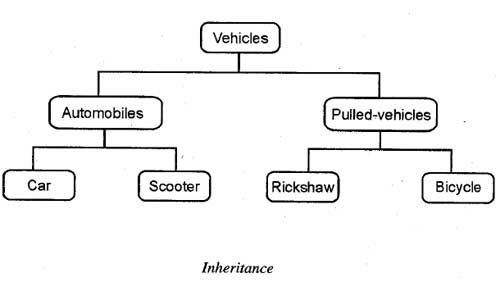Inheritance can be defined as the process whereby an object of a class acquires characteristics from the object of the other class. All the objects of a similar kind are grouped together to form a class. However, sometimes a situation arises when different objects cannot be combined together under a single group as they share only some common characteristics. In this situation, the classes are defined in such a way that the common features are combined to form a generalized class and the specific features are combined to form a specialized class. The specialized class is defined in such a way that in addition to the individual characteristics and functions, it also inherits all the properties and the functions of its generalized class.
For example, in the real world, all the vehicles cannot be automobiles-some of them are pulled-vehicles also. Thus, car and scooter both are vehicles that come under the category of automobiles. Similar, rickshaw and bicycle are the vehicles that come under the category of pulled-vehicles. In other words, automobiles and pulled-vehicles inherit the common properties of the vehicle class and also have some other properties that are not common and differentiate them. Thus, the vehicles class is the generalization of automobiles and pulled-vehicles class, and automobiles and pulled-vehicles classes are the specialized versions of the vehicles class. Note that while inheriting the vehicle class, the automobiles and pulled-vehicles do not modify the properties of the vehicle class, however, can add new properties that are exclusive for them.

In the same way, OOP allows one class to inherit the properties of another class or classes. The class, which is inherited by the other classes, is known as superclass or base class or parent class and the class, which inherits the properties of the base class, is called sub class or derived class or child class. The sub class can further be inherited to form other derived classes. For example, car and scooter are the derived classes of automobiles and rickshaw and bicycle are the derived classes of pulled vehicles
Inheritance can be of two types, namely, single inheritance and multiple inheritance. If a class acquires properties from a single class, it is termed as single inheritance and if it acquires characteristics from two or more classes, it is known as multiple inheritance.
The main advantage of inheritance is reusability. The existing classes can be simply re-used in new software instead of writing a new code. However, new features can be added without altering or modifying the features of the existing class.
While inheriting a base class, a derived class not only inherits the data and functions of its base class, but can also provide a different implementation (definition) for the functions of the base class. In such a case, the base class mayor may not provide an implementation for its function. It only provides the interface for the functions.
A class which provides only the interface of one or more functions and not their implementations is known as an abstract class. An abstract class only specifies what the function does, what all it requires, etc., but it does not specify how the function works. Implementations of such functions are provided in the classes that inherit the abstract class. Note that the instances (objects) of an abstract class cannot be created. This is because it does not provide the implementation of the functions. The class that provides an implementation for all its functions is known as a concrete class. The concrete classes can have one or more objects. Note that derived classes which provide implementation of all the functions that have not been implemented in the abstract class are also considered as concrete classes.
 Dinesh Thakur holds an B.C.A, MCDBA, MCSD certifications. Dinesh authors the hugely popular
Dinesh Thakur holds an B.C.A, MCDBA, MCSD certifications. Dinesh authors the hugely popular